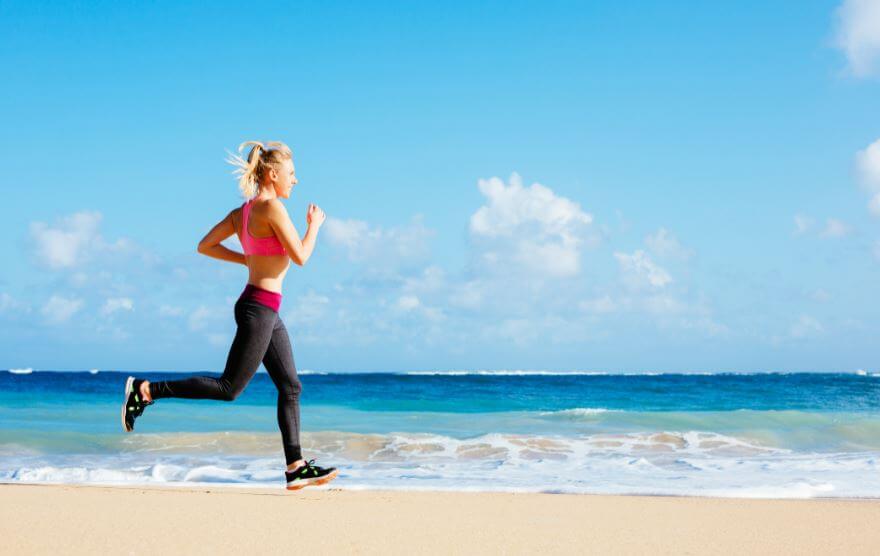Outdoor Sports? Three Common Sunscreen Mistakes

As summer inches closer and the hours of daylight increase, the likelihood of suffering from sunburn rises as well. Sunburn is even more likely if you play outdoor sports. Avoiding the most common sunscreen mistakes is extremely important. Protect your skin adequately to keep it healthy.
Solar radiation
The sun emits radiation in the form of electromagnetic rays that reach earth. As humans, we can differentiate a spectrum that we call visible light, but there are also other waves underneath visible light that we can’t see. These invisible waves are infrared rays; we call them “infrared” because they’re underneath the color red.
But there are other, much more powerful rays that can affect your tissues and produce negative consequences. These waves are ultraviolet rays.
In the ultraviolet wave spectrum, there are three types of rays: UVA, UVB, and UVC. You don’t have to worry about UVC rays as they’re halted in the ozone layer. On the other hand, UVB rays reach your epidermis while UVA can go through to your dermis, which is a deeper layer of your skin.
UVB rays are most commonly linked to sunburn and skin cancer. But they’re also the easiest to defend yourself from.
Common sunscreen mistakes
When you play outdoor sports or exercise outside, you’re stepping out into all of these forms of radiation. In the northern hemisphere, the sun’s rays are especially dangerous during July and August.

In light of the real danger, you should take extra care of your skin during those months to stay as healthy as possible and prevent diseases such as melanoma. Below, check out our list of common sunscreen mistakes:
1. Not using enough protection
We often overestimate the amount of protection a sunscreen offers us. Some people even opt for sunscreens with a lower SPF number or skip it entirely to get a suntan.
Reaching for weaker sunscreen or skipping it entirely is a mistake because epidermis cells can really see a lot of damage as a result. You should always make sure that your skin is well protected even if it means taking longer to reach your ideal tan.
A similar common mistake is failing to cover your most sensitive areas with sunscreen, such as your face or neck. Special creams for these zones are available on the market; these areas are more vulnerable to burns because they receive more direct sunlight than the other areas of your body.
On a similar note, failing to protect certain areas such as your shoulders or around the neckline of your clothing because it’s under your clothes is another mistake. In addition, make sure you hydrate your skin properly after exercising as well.
2. Not using the right kind of protection
Most people use a simple sunscreen, such as one for pools or beaches, to protect themselves from the sun. While these conventional sunscreens might work for a light walk or any activity where you don’t sweat a lot, remember that your sweat will weaken your skin’s absorption of the lotion.
Thus, if you’re going to sweat– which will most likely be the case in summer– you should look for a sunscreen that’s designed to stay on even if you sweat.

3. Not putting on sunscreen before swimming
In the summertime, many people get their exercise by swimming in a pool. While those who plan on enjoying a leisure day at the pool protect themselves with sunscreen, people who go specifically to swim often forget to protect their skin.
But the sun’s rays can harm your skin even if you’re underwater. Thus, you need to use special waterproof sunscreens to keep your skin safe.
In any case, prevention is the best way you can take care of your skin. Protecting yourself from the sun is a crucial habit to develop in order to prevent serious health problems, especially in the summer. It won’t take up too much time or money and you’ll be doing yourself a huge favor!
As summer inches closer and the hours of daylight increase, the likelihood of suffering from sunburn rises as well. Sunburn is even more likely if you play outdoor sports. Avoiding the most common sunscreen mistakes is extremely important. Protect your skin adequately to keep it healthy.
Solar radiation
The sun emits radiation in the form of electromagnetic rays that reach earth. As humans, we can differentiate a spectrum that we call visible light, but there are also other waves underneath visible light that we can’t see. These invisible waves are infrared rays; we call them “infrared” because they’re underneath the color red.
But there are other, much more powerful rays that can affect your tissues and produce negative consequences. These waves are ultraviolet rays.
In the ultraviolet wave spectrum, there are three types of rays: UVA, UVB, and UVC. You don’t have to worry about UVC rays as they’re halted in the ozone layer. On the other hand, UVB rays reach your epidermis while UVA can go through to your dermis, which is a deeper layer of your skin.
UVB rays are most commonly linked to sunburn and skin cancer. But they’re also the easiest to defend yourself from.
Common sunscreen mistakes
When you play outdoor sports or exercise outside, you’re stepping out into all of these forms of radiation. In the northern hemisphere, the sun’s rays are especially dangerous during July and August.

In light of the real danger, you should take extra care of your skin during those months to stay as healthy as possible and prevent diseases such as melanoma. Below, check out our list of common sunscreen mistakes:
1. Not using enough protection
We often overestimate the amount of protection a sunscreen offers us. Some people even opt for sunscreens with a lower SPF number or skip it entirely to get a suntan.
Reaching for weaker sunscreen or skipping it entirely is a mistake because epidermis cells can really see a lot of damage as a result. You should always make sure that your skin is well protected even if it means taking longer to reach your ideal tan.
A similar common mistake is failing to cover your most sensitive areas with sunscreen, such as your face or neck. Special creams for these zones are available on the market; these areas are more vulnerable to burns because they receive more direct sunlight than the other areas of your body.
On a similar note, failing to protect certain areas such as your shoulders or around the neckline of your clothing because it’s under your clothes is another mistake. In addition, make sure you hydrate your skin properly after exercising as well.
2. Not using the right kind of protection
Most people use a simple sunscreen, such as one for pools or beaches, to protect themselves from the sun. While these conventional sunscreens might work for a light walk or any activity where you don’t sweat a lot, remember that your sweat will weaken your skin’s absorption of the lotion.
Thus, if you’re going to sweat– which will most likely be the case in summer– you should look for a sunscreen that’s designed to stay on even if you sweat.

3. Not putting on sunscreen before swimming
In the summertime, many people get their exercise by swimming in a pool. While those who plan on enjoying a leisure day at the pool protect themselves with sunscreen, people who go specifically to swim often forget to protect their skin.
But the sun’s rays can harm your skin even if you’re underwater. Thus, you need to use special waterproof sunscreens to keep your skin safe.
In any case, prevention is the best way you can take care of your skin. Protecting yourself from the sun is a crucial habit to develop in order to prevent serious health problems, especially in the summer. It won’t take up too much time or money and you’ll be doing yourself a huge favor!
All cited sources were thoroughly reviewed by our team to ensure their quality, reliability, currency, and validity. The bibliography of this article was considered reliable and of academic or scientific accuracy.
- Apalla Z, Nashan D, Weller RB, Castellsagué X. Skin Cancer: Epidemiology, Disease Burden, Pathophysiology, Diagnosis and Therapeutic Approaches. Dermatol Ther (Heidelb) [Internet]. 2017 Jan [cited 2019 Jul 10];7(Suppl 1):5–19. Available from: http://www.ncbi.nlm.nih.gov/pubmed/28150105
- Saladi RN, Persaud AN. The causes of skin cancer: A comprehensive review. Drugs of Today [Internet]. 2005 Jan [cited 2019 Jul 10];41(1):37. Available from: http://www.ncbi.nlm.nih.gov/pubmed/15753968
- Jinna S, Adams BB. Ultraviolet Radiation and the Athlete: Risk, Sun Safety, and Barriers to Implementation of Protective Strategies. Sport Med [Internet]. 2013 Jul 9 [cited 2019 Jul 10];43(7):531–7. Available from: http://www.ncbi.nlm.nih.gov/pubmed/23568372
- Harrison SC, Bergfeld WF. Ultraviolet light and skin cancer in athletes. Sports Health [Internet]. 2009 Jul [cited 2019 Jul 10];1(4):335–40. Available from: http://www.ncbi.nlm.nih.gov/pubmed/23015891
This text is provided for informational purposes only and does not replace consultation with a professional. If in doubt, consult your specialist.








